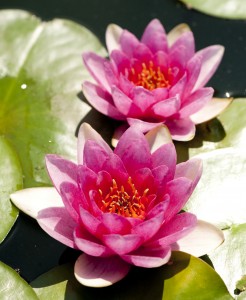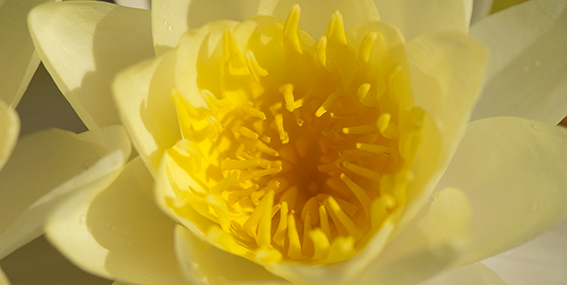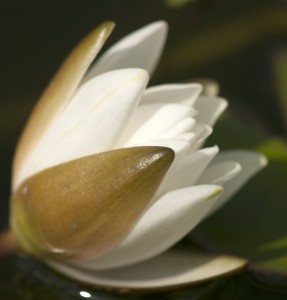Muddy Waters
Posted in Exhibitions, Monet's Garden on October 9 2012, by Sonia Uyterhoeven
Sonia Uyterhoeven is the NYBG‘s Gardener for Public Education.
 For centuries, water lilies have been thought of as emblems of purity and beauty. Philosophers marveled at how a stunning, symmetrically perfect flower–sometimes with a sweet, subtle perfume–was capable of arising from such muddy waters. But if the pristine blooms and large, glossy lily pads give the illusion of cleanliness, every gardener who has ever reached down into a pond to deadhead a spent bloom will attest to the fact that underneath the façade of exquisite beauty is a slimy mess.
For centuries, water lilies have been thought of as emblems of purity and beauty. Philosophers marveled at how a stunning, symmetrically perfect flower–sometimes with a sweet, subtle perfume–was capable of arising from such muddy waters. But if the pristine blooms and large, glossy lily pads give the illusion of cleanliness, every gardener who has ever reached down into a pond to deadhead a spent bloom will attest to the fact that underneath the façade of exquisite beauty is a slimy mess.
As we approach the end of our Monet’s Garden exhibition (Sunday, October 21), the water lily display–one of the centerpieces of the show–is still in its full glory. But while this exhibition took its inspiration from Monet’s garden at Giverny, the artist found his love of the flower elsewhere. Monet’s water garden was transformed when he met Joseph Bory Latour-Marliac, the son of a wealthy, landowning French family. After studying law in Paris, Latour-Marliac returned to his home near Bordeaux to help his father manage his property. As an avid botanist, he soon developed a vast network with horticultural societies and botanists throughout the world.
The water lily was Latour-Marliac’s unmatched passion. The species that he grew up with were the native, double-flowering white variety, Nymphaea alba, and the rather simple looking Nuphar lutea–a single-flowering, yellow relative of water lilies. His world changed when he was first introduced to tropical varieties, with their vivid purple and blue colors and large, electrifying flowers. Soon after, he set his mind to the task of hybridizing a water lily that combined the beauty of the tropical lilies with the hardiness of the wild European water lilies.

Latour-Marliac collected seeds and rhizomes of water lilies from many different countries and for years unsuccessfully tried to hybridize these tropical and temperate water lilies with his native water lily. As some of you may know, it is genetically impossible to cross hardy water lilies with tropical water lilies. A blue hardy water lily is still an elusive dream. Latour-Marliac was, however, able to cross his native water lily, Nymphaea alba, with species from more temperate regions, producing some wonderful varieties in a wide spectrum of colors–primarily yellows, apricots, pinks and reds.
This year we have several of the water lilies that Monet would have purchased from Latour-Marliac at the Paris 1889 Universal Exhibition, featured in our hardy water lily pool along with other classic hardy water lilies that are well-suited for the homeowner.
 Nymphaea ‘Marliacea Carnea’, N. ‘Marliacea Ignea’, and N. ‘Marliacea Chromatella’ are three that bear his name. The colors of the blooms are pale pink, red, and yellow respectively. ‘Marliacea Carnea’ and ‘Marliacea Chromatella’ can both handle part shade but they flower much better in full sun. ‘Marliacea Chromatella’, often referred to simply as ‘Chromatella’, is a classic in the trade. It has mottled foliage.
Nymphaea ‘Marliacea Carnea’, N. ‘Marliacea Ignea’, and N. ‘Marliacea Chromatella’ are three that bear his name. The colors of the blooms are pale pink, red, and yellow respectively. ‘Marliacea Carnea’ and ‘Marliacea Chromatella’ can both handle part shade but they flower much better in full sun. ‘Marliacea Chromatella’, often referred to simply as ‘Chromatella’, is a classic in the trade. It has mottled foliage.
Nymphaea ‘Comanche’ is another one of Latour-Marliac’s hybrids. It is a free-flowering water lily with flowers that start out as a pale apricot and then change to a coppery orange. N. odorata ‘Sulphurea’ is another one of his introductions that has a sweet fragrance and large yellow flowers. It also flowers prolifically and grows from six to eight feet wide.
Water lilies will flower into November in the New York area. Our hardy water lilies will stay in the pool through the winter months. We treat our tropical water lilies as annuals, but it is easy to over-winter the tubers in moist sand, storing them in a cool area.


your blog post is so interesting….very informative…thanks for the reminder that this phenomenal show is ending. So if I understand this correctly, the NYBG plant’s fresh wate lilies in the tropical pool each year? Although, an avid gardner could store the tubers in sand over the winter and get them to bloom again.
Have one more question….how deep is the pool?
One final question which I’ve been dying to ask for months….has anyone ever jumped in to take a macro photo?